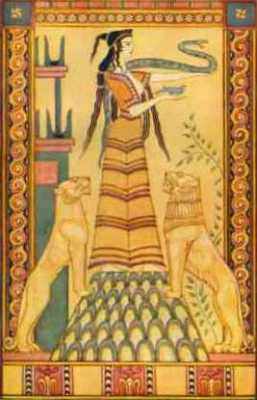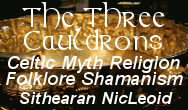Ariadne's Tribe: Minoan Spirituality for the Modern World
Walk the sacred labyrinth with Ariadne, the Minotaur, the Great Mothers, Dionysus, and the rest of the Minoan family of deities. Ariadne's Tribe is an independent spiritual tradition that brings the deities of the ancient Minoans alive in the modern world. We're a revivalist tradition, not a reconstructionist one. We rely heavily on shared gnosis and the practical realities of Paganism in the modern world. Ariadne's thread reaches across the millennia to connect us with the divine. Will you follow where it leads?
Find out all about Ariadne's Tribe at ariadnestribe.com. We're an inclusive, welcoming tradition, open to all who share our love for the Minoan deities and respect for our fellow human beings.
Who were the Minoans' neighbors?
A few weeks back I had a lovely chat with Goddess Spirituality leader Karen Tate on her radio show. We talked about Minoan spirituality (Ariadne's Tribe style) in particular and the ancient Minoans in general. One issue that came up in the conversation was where, in the timeline of the ancient world, the Minoans fit.
Many people seem to think they came after the Greeks and copied much of the Greek pantheon, but the truth is actually the other way around. All those ancient cultures are so far removed from us in time that it can be difficult to get a mental picture of how they all fit together.
So I thought I’d tease out some of the details and help you picture the world of the ancient Minoans – not just Crete but all the cultures and civilizations that were alive and kicking at that time.
I apologize for going all History Teacher on you here, but I’m going to start with some dates, just for reference. I promise I won’t throw too many numbers at you.
Though the island of Crete has been inhabited since prehistoric times, what we think of as Minoan civilization didn’t arise until around 3500 BCE; at that point the people had farms, towns and tombs but no big buildings. The heyday of the Minoans with the big temples, the fancy tech (enclosed sewers, flushing toilets, multi-story buildings) and the beautiful artwork ran for just a few centuries, from about 1900 to 1400 BCE.
After that, the culture declined, the Mycenaean Greeks occupied and eventually destroyed the big cities, and the civilization that we think of as Minoan pretty much ceased to exist.
So…what else was going on in the world while the Minoans on Crete were doing their thing?
The Old Kingdom of Egypt began in 3100 BCE, just a few centuries after the rise of early Minoan civilization. The heyday of the Minoans coincided with the 12th through the 18th Dynasties in Egypt (the end of the Old Kingdom, the Second Intermediate Period, and the beginning of the New Kingdom). The height of Minoan culture occurred around the same time as many of the big names you’re probably familiar with in Egyptian history: Hatshepsut, Akhenaten, Nefertiti, Tutankhamun.
The Egyptians were major trading partners for the Minoans. We’ve found Egyptian paintings depicting people from Crete bearing gifts and trade goods. And a number of Minoan-style frescoes were discovered at the site of Tell el-Daba (the ancient city of Avaris) in the Nile Delta. These lovely pieces of art depict Minoan subjects such as bull-leaping and griffins, and may have been painted either by native Minoan artists living in Egypt or by Egyptian artists who were imitating the popular Minoan style.
But the Egyptians weren’t the only people around at that time. And believe me, if there were people to trade with, the Minoans did it.
The culture of Sumer in Lower Mesopotamia arose at about the same time as early Minoan civilization. A few centuries later, while the Minoans were still perking along, Sargon of Akkad conquered the Sumerian city-states and united them, founding the Akkadian Empire.
Then the Babylonian Empire arose in the same region while the Minoans were building and rebuilding their glorious temples. Hammurabi with his well-known laws lived right about the same time as the Minoans were building the first versions of the temples in Knossos, Phaistos, Malia and Kato Zakro. As you can tell, the Middle East wasn’t nearly as peaceful a region as Crete, but then, the island had the advantage of Grandmother Ocean guarding its borders.
The famous Epic of Gilgamesh, a Mesopotamian poem that's the oldest great work of literature we've yet found, was composed while Minoan culture was at its height. The legendary King Gilgamesh, the titular hero of the story, supposedly lived during the same time as early Minoan civilization.
I hope one day we’ll discover an epic work of literature written by the Minoans. Not only will that give us a window into their lives, it will also provide us with the material we need to translate their written language, Linear A.
What about other regions of the world? What was going on elsewhere while the Minoans were busy painting frescoes and leaping bulls?
The first stage of Stonehenge was built during the early days of Minoan civilization, while the people of Crete were collecting up in towns but before they began planning their big temples. The final stage of rearranging stones and dirt at Stonehenge took place during the height of Minoan culture. While the Britons were processing around their magnificent stone circle, the Minoans were processing down paved viaducts into their temples.
The mysterious Harappan culture of the Indus Valley flourished during roughly the same time as the Minoans. It’s possible the Minoans traded with them via overland routes, much as they traded with people in the Middle East, though sea travel was the Minoan specialty and the Mediterranean was their preferred venue.
The legendary Yellow Emperor of China lived while Minoan culture was just beginning. The Xia and Shang Dynasties, the first two historically-attested dynasties of Chinese civilization, ruled from the time the Minoans were just beginning until the collapse of Crete’s native culture.
But what about the Greeks? The Mycenaeans, the Bronze Age Greeks, arose as a culture during the last couple centuries of Minoan civilization. And guess what? Their rise is largely attributed to the influence of the Minoans.
The Helladic Greeks were a bit on the primitive side compared to the Minoans; it was Minoan culture that allowed them to blossom into the Mycenaean Greeks we know from epics such as Homer’s Iliad and Odyssey. From Crete they learned how to build beehive-shaped tombs, how to write, how to improve their pottery and jewelry-making. But unlike the Minoans, their culture was warlike and profited mainly from conquest rather than trade.
It's probable that the Mycenaeans borrowed many of the deities from the Minoan pantheon into their own religious practice. Dionysus, Potnia, Eileithyia, Rhea and others began their legendary lives on Crete but eventually made their way into Greek mythology.
What many people don’t realize is that the Mycenaeans – the Greeks of the Homeric epics – are not the same as the classical Greeks from whom the extensive philosophy, literature, and mythology come down to us.
Along with the other cultures of the eastern Mediterranean and the Near East, Mycenaean civilization collapsed around the year 1200 BCE. Whether this disintegration was caused by natural disasters, warfare or societal collapse due to overuse of natural resources – or all three – is still debated. But this crumbling of cultures, the Late Bronze Age collapse, led to a time that's referred to as the Greek Dark Ages.
These few centuries involved the loss of literacy in mainland Greece, the destruction of Mycenaean cities and palaces, and a resulting struggle for survival among people in the region. It wasn’t until the eighth century BCE that things began to look better, and classical Greek civilization – what we usually think of when people mention ‘ancient Greece’ – didn’t reach its stride until about the fifth century BCE, a full millennium after the destruction of the Minoan cities.
Now you know: classical Greece is really quite late compared to the Minoans.
We hear about the Greeks because so much of their literature has survived and has long been considered part of a good education. Popular classical revivals during the Renaissance and again during Victorian times have helped to underscore the misunderstanding that western civilization began in classical Greece.
In fact, most history texts begin with the Greeks and don’t even mention the Minoans – though interestingly, they do often include the Mesopotamian cultures that thrived about the same time as Minoan civilization.
So there you have it. The Minoans came before the Greeks. Both were fascinating cultures and left us wonderful legacies to ponder. I just want to be sure the Minoans are provided their rightful placed in the history of the world.
Comments
-
Please login first in order for you to submit comments




















